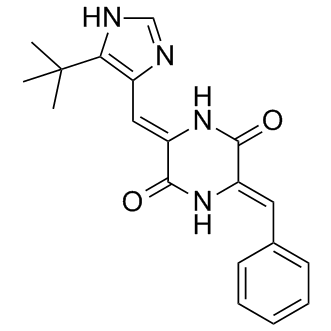| Cas No.: | 714272-27-2 |
| Chemical Name: | NPI-2358; NPI 2358 |
| Synonyms: | NPI-2358; NPI 2358 |
| SMILES: | C1C=CC(/C=C2\NC(=O)/C(=C/C3N=CNC=3C(C)(C)C)/NC\2=O)=CC=1 |
| Formula: | C19H20N4O2 |
| M.Wt: | 336.39 |
| Sotrage: | 2 years -20°C Powder, 2 weeks 4°C in DMSO, 6 months -80°C in DMSO |
| Description: | Plinabulin (NPI-2358) is a vascular disrupting agents (VDA) against tubulin-depolymerizing with IC50 of 9.8~18 nM in tumor cells. |
| In Vivo: | NPI-2358 (7.5 mg/kg) inhibits tumor growth in human plasmacytoma mouse xenograft models at well-tolerated doses. NPI-2358 induces a time- and dose-dependent decrease in tumour perfusion. NPI-2358 is more sensitive to the KHT sarcoma than the C3H tumour, while radiation response could enhance the antitumor activity in both models. |
| In Vitro: | NPI-2358 binds to the colchicine-binding site of tubulin and has potent inhibitory to human tumor cell lines which have overexpressed Pgp or reduced nuclear Topo II catalytic activity, with IC50 from 9.8 to 18 nM. NPI-2358 is able to rapidly induce tubulin depolymerization in HUVECs and monolayer permeability even at 20 nM. NPI-2358 induces cell death in MM cells with IC50 of 8-10 nM, which due to trigger early mitotic arrest in MM cells. NPI-2358 also inhibits tubule formation and migration of endothelial as well as MM cells, which leads to disrupt tumor vasculature. NPI-2358 could induces cell death in patient MM (CD138+) cells without effecting viability of normal mononuclear cells. Blockade of JNK abrogates NPI-2358-induced mitotic arrest or MM cell death. |

 DC Chemicals' products qualify for U.S. tariff exemptions. We guarantee no price increases due to customs duties and maintain stable supply, continuing to deliver reliable research solutions to our American clients.
DC Chemicals' products qualify for U.S. tariff exemptions. We guarantee no price increases due to customs duties and maintain stable supply, continuing to deliver reliable research solutions to our American clients.





















